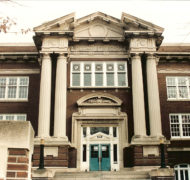What Was, What Is and What Will Be
Blog / Produced by The High Calling
I grew up in the South in the waning days of segregation. I can remember separate water fountains and public bathrooms; separate seating at the movie theater and on the bus. And separate schools.
I knew these things as a child; they were what was.
Integration had started the year before I began high school. It was ugly that first year, and you could watch it on the news every night. The next year, it was no big deal. It had become part of what was.
Later, each place I worked—a college newspaper, a small town paper, three large corporations—was predominately white. Not by design or intent, but by what was. Then, for nine months in 2003 and 2004, I led Communications for the St. Louis Public Schools.
The system was in convulsions; an outside management firm had been hired to restructure, downsize, outsource, and streamline. I was brought in some months after the firm’s arrival, after the current PR director had left. My biggest problem was this: I was white and I was male. I was a double minority. I was part of what wasn’t. My first week on the job, my department went out for lunch. I wasn’t invited. I’d never been in that kind of situation before. I’d never even thought about that kind of situation before.
I was viewed with suspicion.
Most employees saw the management firm as the enemy, the people who were taking away their jobs. The management firm was exclusively white. Most of the employees were black. There was often a willingness to misunderstand on both sides. I shuttled back and forth between them, but I was in one group and wasn’t in another.
I had to work twice as hard as others.
No one said anything, but I had to prove my ability to do the work and that I could be trusted. People simply didn’t want to tell me things that they thought might get them into trouble or they thought I might repeat to the superintendent or one of his people or that might end up on the local news. You don’t trust wasn’t.
I had to work through intimidation.
There were people of both races in the central office who refused to go into the high schools because of fear of bodily harm. This reluctance was a real problem, because we were doing considerable community outreach through these schools. That was a physical safety issue.
But then there were people who would try to make me back down because of what my skin color was, and I had to stand firm. So what did I do? I worked twice as hard. When a school needed communications help, I was there. When a mob of news media covered a school board member attacking an administrator, I took it on. When a central office administrator was unfairly criticized or a principal was under attack for no good reason, I defended. When someone was getting rightly barbecued, I helped prepare them for the grilling. Slowly, was became is.
I refused to be intimidated. I went into school situations that would give anyone pause; I got used to it and stopped thinking about it. It became part of what was—shootings, food poisonings, school board meetings that turned into riots. I kept telling myself that 40,000 children experienced these things all the time and, like some of the heroic people teaching them, I had to focus on what is and will be.
The peak came the night I walked through a crowd of more than 2,000 very angry people waiting outside a board meeting, and I walked calmly through, smiling at people I knew. I was recognized as the public face of the school district, and the crowd parted to let me through (the board members had to be slipped through a secure building entrance). It was the moment I knew I was accepted. I had become part of what is.
And, in every situation, I wore my faith publicly. That’s an odd thing to do in the workplace, but in that workplace, my faith mattered. In fact, I later learned it was one of the reasons I was hired. Faith was important to so many people that I could talk with them in ways that others couldn’t. I could tell someone I’d pray for them, and they knew it wasn’t a throwaway line.
Faith is always about what is and what will be.
It was the most intense work experience of my career. I learned a lot, but most of all, I learned how to pay attention to what was. Mostly, that it didn’t mean what is or what will be.




